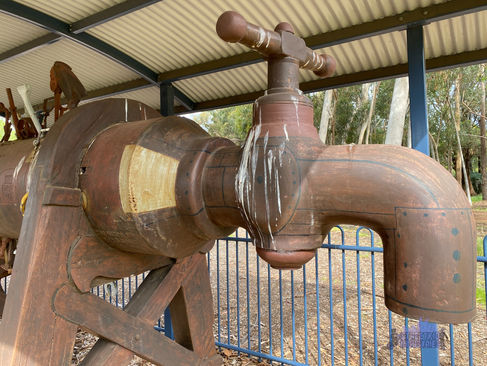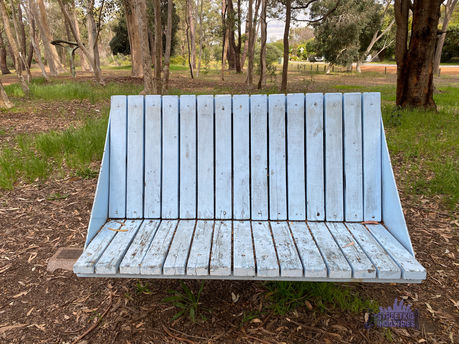Mundaring Sculpture Park
Tucked away in the heart of Mundaring lies the Mundaring Sculpture Park, a place that blends history, art and community in a way that few parks manage to do. It’s a family-friendly space filled with imaginative sculptures, shady trees and picnic areas but the ground it sits on has a much older story to tell.
A Railway Past
Long before it became a park, this land was part of the Eastern Railway system, one of the key transport routes opening up the Perth Hills in the late 19th century. The Mundaring Branch Line, which ran from Bellevue to Mundaring, was laid in 1884. It played an important role in linking the hill communities with Perth, not only for carrying passengers but also freight vital for development in the region.
%20and%20the%20Eastern%20Railway%20line%20at%20Mount%20Hel.jpg)
P17574 - Junction of the Mundaring line (M line) and the Eastern Railway line at Mount Helena, view to the west, Mundaring line disconnected, ER line.
When work began on the Goldfields Water Supply Scheme, the line became even more important. It helped move heavy equipment and materials needed to build the Mundaring Weir and the vast pipeline system that would bring fresh water to the goldfields.
For decades, the trains were a lifeline for the town but by the mid-20th century, cars and trucks had taken over and the line was no longer needed. The Mundaring Branch Line was officially closed in 1954 and the tracks were soon removed.
A Park is Born
It wasn’t until the 1980s that an idea for the site began to take shape. As part of Australia’s 1988 Bicentenary celebrations, the community transformed the old railway land into a public park. Instead of just a playground or stretch of green space, it was designed to showcase sculpture and art in a natural setting.
The railway formation can still be traced through the park, with embankments and cuttings, hinting at where trains once ran.
The People Behind the Park
The park’s creation was a community-driven project, shaped by a number of people:
-
Ross Donaldson - then Shire President, helped guide the project through its early stages and ensured it had council support.
-
Phil Palmer - a passionate community advocate who played a key role in the development and promotion of the park.
-
Trevor Woodward - a local artist who contributed to the artistic vision, creating works that remain part of the park’s character and inspiring the idea of blending public art with natural landscape.
The Artists
The first sculptures in the park were created by some of Western Australia’s most respected artists. Hans Arkeveld, who built a career exploring the human form with both scientific accuracy and imagination, contributed a work called Mainstream in 1988.
Another key contributor was Ron Gomboc, who arrived in Australia from Slovenia as a teenager and went on to become one of WA’s best-known sculptors. He established the Gomboc Gallery Sculpture Park in Middle Swan in 1982 and later designed the famous AACTA film and television award statuette. His piece for Mundaring called Missed the Last Train, reflects the humour and accessibility that define much of the collection.
Other artists, including Richard Fry, Peter Dailey, John Tarry and Stuart Elliott, added works that helped give the park its distinctive character. Dailey’s Tractor, Tarry’s Mother bench and Elliott’s satirical Tourists figure were among those installed in the early years. Although some soon suffered from vandalism, they were restored by mid-1990.
Mainstream by Hans Arkeveld (1988)
Mainstream is one of Hans Arkeveld’s standout works at Mundaring Sculpture Park, created in 1988 when the park first opened.
The sculpture takes simple, everyday items—a water pipe, tap and wheelbarrow—and turns them into something symbolic. It serves as a light-hearted yet thought provoking reminder of Mundaring’s key role in Western Australia’s water story. The park sits just a short distance from Mundaring Weir, the engineering feat that made it possible to pump water hundreds of kilometres to the Eastern Goldfields. Through this playful use of pipes and water imagery, Mainstream ties the park to a much bigger story of resilience, ingenuity and growth.
Arkeveld, whose wider career was often shaped by themes of anatomy, biology and natural history, approached Mainstream with humour and accessibility. The result is a sculpture that is easy to engage with but still rich in meaning—linking the local landscape to the vital flow of water that helped shape the state’s development.

Tractor by Peter Dailey (1988)
Peter Dailey’s Tractor was among the very first sculptures revealed at Mundaring Sculpture Park when it officially opened on 11 September 1988 during Australia’s Bicentenary celebrations. Designed as a kind of sculptural bench, it reflects the park’s early focus on playful, hands-on artworks that invite people to sit, interact and enjoy their surroundings. Dailey himself is a well-regarded Western Australian artist, teacher, and mentor, known for his exhibitions as well as a number of significant public art projects across the state.

Tourists by Stuart Elliott (1988)
Stuart Elliott’s Tourists takes a light-hearted look at the funny side of tourism. The figures, decked out in brightly patterned clothes and comical hats, seem both awkwardly out of place and oddly at home at the same time. Through this contrast, the sculpture gently pokes fun at cultural habits while still celebrating them with warmth and humour. Since it was first installed, it has become one of the park’s standout attractions, remembered fondly for its playful character and clever satire that appeals to visitors of all ages.

The Gate House by Michael Arnold (2004)

The Ornate Crevice Dragon by Nic Compton (2015)
He is a Western Australian artist whose creative style reflects both his Māori heritage and the landscapes of New Zealand and Australia. He often works with natural materials such as timber and stone, shaping them into pieces that draw on traditional Māori and Pacific carving styles. His art carries a strong sense of energy and cultural depth—what the Māori call mana. The Ornate Crevice Dragon pays tribute to the small lizards found around Mundaring and the Weir, creatures less than 30 centimetres long that are experts at blending into the granite rocks where they live.

Le Rêve & Le Choix by Richard Fry (1988)
Richard Fry’s sculptures were added to the Mundaring Sculpture Park in 1988, when the old Eastern Railway yard was first turned into a community space. His works are shaped around ideas of aspiration, choices and the journeys we take through life. Using abstract carved timber mixed with symbolic elements, Fry created pieces that encourage people to stop and think about their own direction as they wander through the park. Rather than just serving as decoration, his art is intended to be part of the experience—something that prompts reflection and imagination along the way.

Insects & Reptiles by Hans Arkeveld (1988)
The insect and reptile sculptures scattered throughout the Mundaring Sculpture Park’s playground, from the giant beetles and grasshopper to the millipede fossil and the hatching reptile, were the work of Hans Arkeveld. A respected Western Australian sculptor and teacher, Arkeveld often drew inspiration from anatomy, biology and the natural world.

A Place of Play and Imagination
Today, the Mundaring Sculpture Park is a popular spot for families, walkers and visitors exploring the Perth Hills. It combines an adventure playground with public art, many of the sculptures designed to be touched, climbed on or simply enjoyed as part of the landscape. The park is also part of the Railway Reserves Heritage Trail, a 41-kilometre loop that follows the old Eastern Railway lines, so history and recreation meet seamlessly here.
From Trains to Treasures
The park is a reminder of how places can be reinvented. Where trains once steamed through the hills carrying water scheme workers and passengers, there is now art, play and community life. The transformation from a railway siding to a sculpture park shows how history doesn’t have to be erased — it can be reimagined, giving old spaces a new purpose while still keeping their stories alive.

.png)




















































